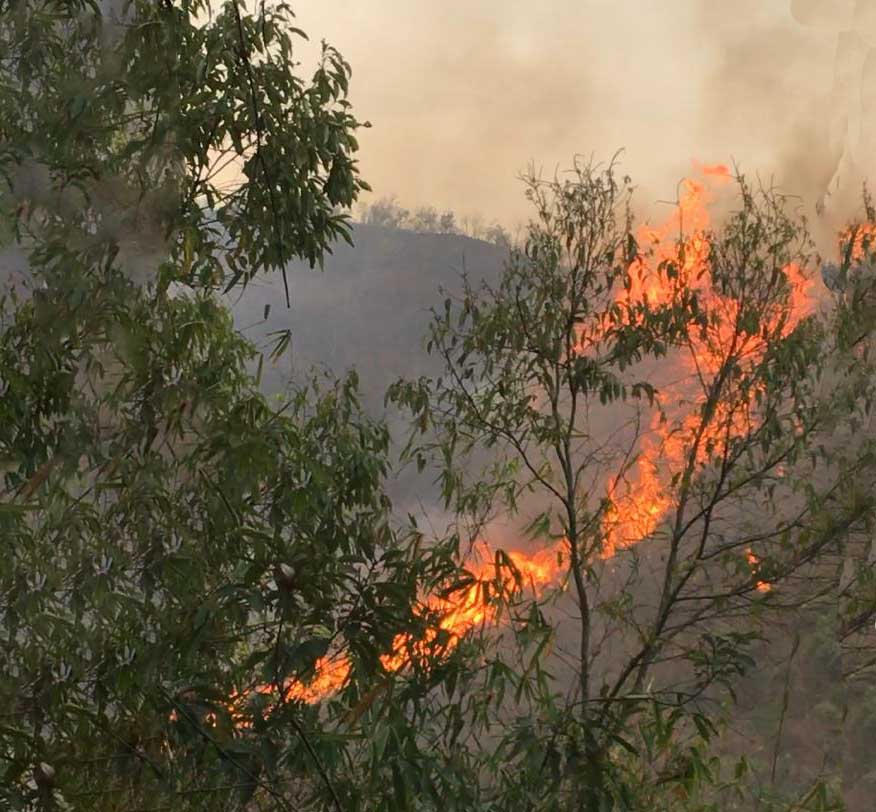“Forest is our life, why are we destroying it. Pls wake up. Local people can protect our forest, not by anyone. We will face shortage of water, oxygen to breathe. Why don’t we understand? Pls wake up dear NGOs and CSOS. Let’s save our life and the future,” tweets Manipur chief minister, N. Biren Singh expressing his growing concerns on spurt of forest fires in the state.
According to satellite data made available by the Forest Survey of India, Manipur has lost at least 3,823 hectares of forest in just 13 days, to forest fire that have occurred, between 1st April to 13rd April, across the state. This is only a preliminary assessment of the damage calculated using the conventional thumb-up of a ‘hectare lost to one case forest fire.’
As per the satellite imagery released by the forest survey of India, Ukhrul and Kamjong districts combined tops the list with 943 forest fire incidents while Churchandpur and Pherzawl rank second as the worst affected districts by the fire with 907 cases. Tengnoupal and Chandel districts clubbed together come third with 885 fire incidences. Although numerically speaking, Imphal West and East districts, which constitutes the central division, accounted for only 73 forest fire incidences, the intangible losses of these fire are huge revealed RK Amarjit Singh, the divisional forest officer with the forest department of Manipur.
“The reserved forest that are located in the Imphal valley like the Phayeng, Langol, Heingang, Baruni and the Nongmaiching reserved forests, function very much like the lungs and kidneys of the valley. They purify the air and enriched the oxygen. The fire incidences have caused irreparable damages,” said the IFS officer.
Attributing the ongoing lockdown as one of the causes for the recent forest fire raging the reserved forest areas especially in the populated areas of Imphal valley, RK Amarjit Singh said, “these forest reserves areas in the valley are becoming chosen areas for gathering of youngsters during the lockdown. Cigarettes butts thrown by the youth accidentally spark of these fires.” He further added that lockdown has also induced an upsurge in hunting with hunting groups burning down forest to flush out animals. “It would take at least 25-30 years to rejuvenate the forest. The fires has completely destroyed the bio-geo-chemical circle, the micro-organisms, soil nutrients and bio diversity of the forest,” laments RK Amarjit Singh.
In case of the recent forest fire that blazed through 50 hectares of the green cover of Punsilok, a part of the Langol reserved forest, situated in the fringe of Imphal city, it turned out that a chowkidaar of the PHED accidentally started the fire when he decided to burn the waste gathering at the water supply compound. It spread to the surrounding forest with dried leaves catching the fire. For Moirangthem Loiyangamba, the leader of Wildlife and Habitat Protection Society (WAHPS) who dedicated 18 years of his life, living on the barren slopes of the Langol reserved forest, and succeeded in rejuvenating 300 acres lush green forest at Punsilok, by tirelessly planting trees and protecting the green canopy by digging trenches called ‘fire-lines’ to ward off accidental fires, the accident was yet again another heart-wrecking incident that ruined his labor of love. “Fortunately our fire-lines could fight off the fire quite well and our volunteers were there too. The fire consumed only the shrubby portion of the forest,” revealed the forest-man as he sometimes called.
Principal Chief Conservator of Forest, K Angami while acknowledging the rising incidence of forest fires in the state said his department is on high alert to prevent further occurrence of fire and at least 32 persons involved in starting the fire have been arrested. The top executive of Manipur’s forest department added that poppy cultivation accounts as the main factor of the fires, particularly in the remote hill districts where villagers are resorting to the largescale cultivation of the opium flower. “The forests are deliberately set on fire by individuals to clear land which they then use for poppy cultivation,” Angami had told PTI.
Based on the interpretation of IRS Resourcesat-2LISS III satellite data for the period Oct 2017 to Feb 2018, the forest cover in the state is 16,846.90 sq km, which is 75.46% of the state’s geographical area. This indicate a decrease by 499.10 sq km as compared to previous assessment reported in ISFR 2017. Tamenglong district has the most dense forest with 388.90 sq km. Senapati comes next with 270.75 sk km, followed by Ukhrul with 192.94 sq km.










